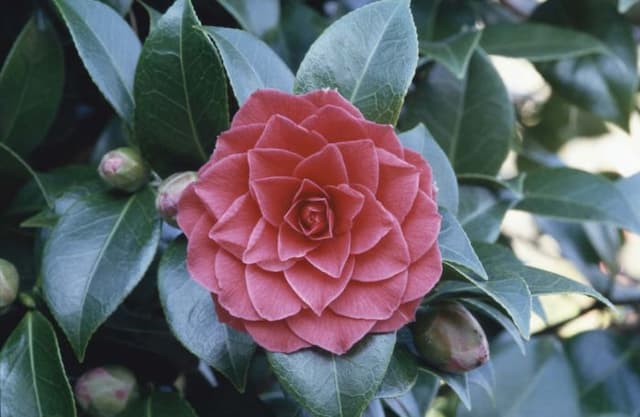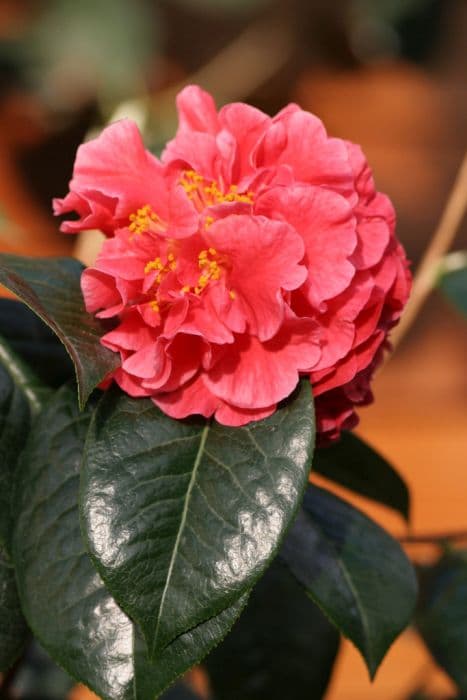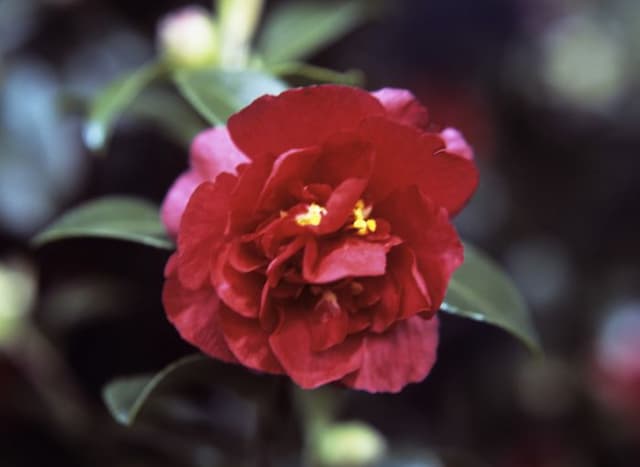Japanese Camellia Camellia japonica 'Hagoromo'

ABOUT
The Camellia japonica 'Hagoromo', commonly known as Japanese camellia, is notable for its lush evergreen foliage and stunning flowers. The leaves of this plant are glossy and dark green, providing a beautiful contrast to the flowers. These leaves are oval shaped with slightly serrated edges that give them a refined appearance. The flowers are the most captivating feature of the Japanese camellia 'Hagoromo'. They bloom in a gorgeous shade of pink that varies in intensity, ranging from a soft pastel to a deeper, more vibrant hue. Each flower is large and has multiple layers of petals that elegantly unfurl to create a full, rounded blossom. The petals have a delicate texture and are arranged in a formal double pattern, which means they are very symmetrical and may look almost ruffled. The flowers resemble a classic rose, with the numerous petals adding depth and a luxurious feel. Inside the flower, the stamens are usually hidden by the numerous petals, contributing to the flower's dense form. When fully open, the blooms exude a subtle and alluring fragrance that can infuse the surrounding area with a sweet, floral scent. The Japanese camellia 'Hagoromo' offers an eye-catching display whether in bloom or solely with its attractive greenery. This plant's elegant appearance makes it a popular choice for ornamental gardens, and its long-lasting blooms provide a touch of beauty during the flowering season.
About this plant
 Names
NamesFamily
Theaceae.
Synonyms
Japanese Camellia, Japonica, Common Camellia, Rose of Winter.
Common names
Camellia japonica 'Hagoromo'.
 Toxicity
ToxicityTo humans
The common name of Camellia japonica 'Hagoromo' is Japanese camellia. This plant is generally considered non-toxic to humans, and there are no significant toxic effects reported from ingesting parts of this plant.
To pets
The common name of Camellia japonica 'Hagoromo' is Japanese camellia. This plant is generally considered non-toxic to pets such as cats and dogs. There should be no significant symptoms of poisoning if a pet ingests parts of the Japanese camellia. However, it is always best to prevent pets from eating plants as individual animals may have different sensitivities or allergic reactions.
 Characteristics
CharacteristicsLife cycle
Perennials
Foliage type
Evergreen
Color of leaves
Green
Flower color
Varies
Height
6-12 feet (1.8-3.7 meters)
Spread
6-10 feet (1.8-3 meters)
Plant type
Shrub
Hardiness zones
7
Native area
Japan
Benefits
 General Benefits
General Benefits- Ornamental Appeal: Camellia japonica 'Hagoromo', commonly known as the Japanese camellia, has large, beautiful flowers that add ornamental value to gardens and landscapes.
- Long Blooming Season: Japanese camellias typically have a long blooming season that can last from late winter through spring, providing color during a time when many other plants are dormant.
- Evergreen Foliage: The plant has glossy, evergreen leaves that provide year-round interest and greenery in the garden.
- Drought Resistance: Once established, Japanese camellias can tolerate periods of drought, making them suitable for gardens with less consistent watering.
- Shade Tolerance: Camellia japonica 'Hagoromo' can thrive in partial shade, which makes it an excellent choice for shaded garden areas where other flowering plants might struggle.
- Variety of Uses: This plant can be utilized in various landscape designs, including as specimen plants, in foundation plantings, or as part of a shrub border.
- Wildlife Attraction: The flowers can attract pollinators such as bees, providing ecological benefits to the garden environment.
- Cold Tolerance: Japanese camellias are relatively cold-hardy and can withstand temperatures lower than many other camellia varieties, extending their suitability to different climates.
 Medical Properties
Medical PropertiesThis plant is not used for medical purposes.
 Air-purifying Qualities
Air-purifying QualitiesThis plant is not specifically known for air purifying qualities.
 Other Uses
Other Uses- Culinary Garnishing: The petals of the Camellia japonica can be used to add a vibrant touch to salads and desserts for an ornamental garnish.
- Textile Dye: The petals can be used to produce natural dyes for fabrics, providing a range of pink hues.
- Art Supplies: The pigments from crushed petals of Camellia japonica can be mixed with binders to create watercolor paints.
- Hair Care: Infused oil made from Camellia petals can provide shine and conditioning to hair when used as a natural treatment.
- Candle Making: Dried Camellia flowers can be incorporated into candle wax for decorative purposes and to add a mild fragrance when burnt.
- Traditional Crafts: In Japan, the Camellia flowers and leaves are used in the crafting of Tsubaki-bana, decorative items in various ceremonies.
- Perfumery: Although not common, Camellia japonica can contribute to the aromatic profile in the crafting of perfumes.
- Handmade Paper: Petals can be integrated into the papermaking process for creating artisan paper with floral inclusions.
- Photography: The distinct flowers of Camellia japonica make it a popular subject for botanical and artistic photography.
- Religious Offerings: In some cultures, Camellia flowers are used as offerings due to their beauty and association with perfection and longevity.
Interesting Facts
 Feng Shui
Feng ShuiThe Camellia is not used in Feng Shui practice.
 Plant Symbolism
Plant Symbolism- Adoration: The Camellia japonica, commonly known as Camellia, is often associated with deep adoration and affection, making it a common gift between lovers and close friends.
- Perfection: With its perfect, symmetrical bloom form, the Camellia is seen as a symbol of ideal beauty and perfection, signifying the admiree's flawless qualities.
- Longevity: Camellias are evergreen and can live for many years; hence, they are seen as a representation of long life and enduring commitment.
- Devotion: Historically, the Camellia has been used to express sincere devotion and fidelity, often exchanged between couples to assert commitment.
- Divine: The name 'Hagoromo,' which translates to "feathered robe" in Japanese, is a reference to a heavenly garment in Japanese mythology, giving the Camellia a divine or otherworldly symbolism.
 Water
WaterJapanese camellias should be watered deeply but infrequently, ensuring the soil is moist but not soggy. Watering should be performed when the top 1-2 inches of soil become dry. Typically, this means watering every 5 to 7 days during the growing season, depending on weather conditions. It is important to reduce watering during the dormant winter months. Water with 1-2 gallons per week for established plants, adjusting based on precipitation and temperature conditions to maintain consistent soil moisture.
 Light
LightJapanese camellias prefer bright, indirect light or partial shade. They should be positioned where they receive morning sun and afternoon shade to protect the foliage and blossoms from the harsh midday sun. An ideal spot is under the canopy of tall trees that provide dappled sunlight, mimicking their natural woodland habitat.
 Temperature
TemperatureJapanese camellias thrive best in temperatures between 60°F and 80°F. They can survive minimal winter temperature dips to around 20°F but sustained exposure below this can damage the plant. The ideal temperature range is crucial to ensure the plant's health and successful flowering.
 Pruning
PruningPrune Japanese camellias to maintain shape, remove dead or weak wood, and promote healthy growth. The best time to prune is just after they finish blooming in spring. Pruning should be done once a year, as over-pruning can reduce flowering. Selective thinning rather than shearing encourages more blooms the following season.
 Cleaning
CleaningAs needed
 Soil
SoilJapanese Camellia 'Hagoromo' thrives in well-draining, acidic soil with a pH between 5.5 and 6.5. The best soil mix includes equal parts of pine bark, sphagnum peat moss, and perlite or sand, which ensures proper aeration and moisture retention.
 Repotting
RepottingJapanese Camellia 'Hagoromo' typically needs repotting every 2 to 3 years, or when it becomes root-bound. It's best to repot in late winter or early spring before the flowering season begins.
 Suitable locations
Suitable locationsIndoor
Place in bright, indirect light; ensure high humidity levels.
Outdoor
Plant in partial shade, shelter from strong winds, well-draining soil.
Hardiness zone
7-9 USDA
 Life cycle
Life cycleThe Camellia japonica 'Hagoromo', commonly known as Japanese Camellia, begins its life cycle as a seed, which germinates in favorable conditions of moisture and temperature to produce a small seedling. The seedling grows through a vegetative stage, developing a root system, stems, and leaves, until it reaches maturity and becomes capable of flowering. During the flowering stage, which typically occurs between late winter and spring, the Japanese Camellia produces large, showy flowers in various colors, attracting pollinators for sexual reproduction. Following pollination, the ovaries develop into seed pods called capsules, which, upon maturing, open to release seeds, thus completing the reproductive cycle. Between flowering periods, the plant enters a growth maintenance phase, where it focuses on leaf production and strengthening its overall structure to survive year-round, including the cooler winter months. Throughout its life, the Japanese Camellia may also propagate vegetatively through cuttings, allowing gardeners to clone and spread identical plants.
 Propogation
PropogationPropogation time
Spring-Early Summer
Propogation: The most popular method of propagating Camellia japonica 'Hagoromo', commonly known as the Japanese camellia, is through semi-hardwood cuttings. This process is typically done in late summer or early autumn when the current year's growth has begun to mature but is not yet fully hardened. To propagate, select a healthy branch and cut a piece around 4 to 6 inches (10 to 15 centimeters) in length, ensuring there are at least two sets of leaves. The lower leaves are removed, and the cut end is dipped in rooting hormone to encourage root development. The cutting is then placed in a pot filled with a mix of peat and perlite, ensuring the environment is humid and well-lit but not in direct sunlight. Roots generally develop within 6 to 8 weeks, after which the cutting can gradually acclimate to less controlled conditions.









